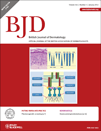Ultraviolet-induced red fluorescence of patients with acne reflects regional casual sebum level and acne lesion distribution: qualitative and quantitative analyses of facial fluorescence
Funding sources This study was supported by grant 02-2010-027 from Seoul National University Bundang Hospital, Korea.
Conflicts of interest None declared.
Summary
Background The ultraviolet (UV)-induced red fluorescence of patients with acne has been considered to be caused by Propionibacterium acnes.
Objectives To study the correlation of the facial red fluorescence with the casual sebum level and the number of acne lesions and to investigate the difference in clinical features, according to both distribution and proportion of fluorescence.
Methods A total of 878 patients clinically diagnosed with acne vulgaris were included. Inflammatory and noninflammatory acne lesions were counted separately. UV fluorescent photography and casual sebum level measurements were performed. UV-induced fluorescence patterns were classified according to the facial distribution. The proportions of UV-induced red fluorescence were calculated.
Results We identified six different fluorescence distribution patterns in the T-zone (the forehead, nose and chin) and three different patterns in the U-zone (both cheeks). The proportion of fluorescence in the U-zone showed a positive correlation with the casual sebum level and the number of acne lesions. In the T-zone, the fluorescence proportion correlated with the casual sebum level, but not with the number of acne lesions. As the patients’ age and the age at onset increased, the distribution of fluorescence changed from the upper part of the T-zone to the lower part, and to the centre of the face in the U-zone.
Conclusions Our results support the hypothesis that the origin of facial red fluorescence is sebum. In patients with acne, analyses of the pattern and proportion of UV-induced red fluorescence can be useful for evaluating the sebum secretion and selecting efficient treatment modalities.




